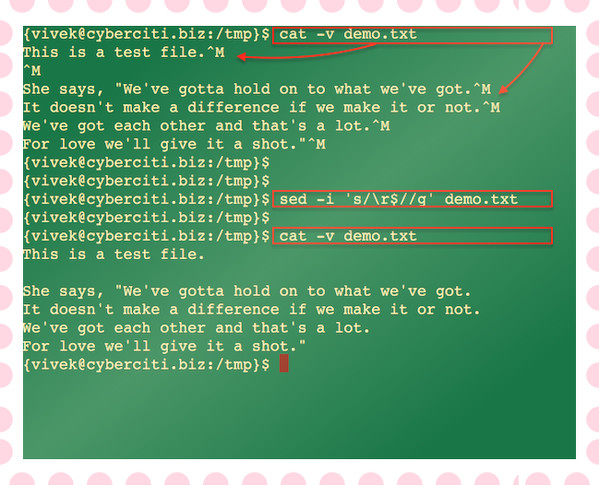A newline is nothing but end of line (EOL). It is a special character or sequence of characters signifying the end of a line of text and the start of a new line. The actual codes representing a newline vary across operating systems. For example CR+LF is used by Microsoft Windows, DOS (MS-DOS, PC DOS, etc.). LF is used by Unix and Unix-like systems including Linux, OS X, FreeBSD and more. The procedure is as follows:
Type the following sed command to delete a carriage Return (CR)
sed 's/\r//' input > output
Type the following sed command to replace a linefeed(LF)
sed ':a;N;$!ba;s/\n//g' input > output
Delete a carriage return (CR) with sed command
The substitute command syntax is as follows (to get ^M type CTRL+V followed by CTRL+M i.e. don’t just type the carat symbol and a capital M. It will not work):
OR easy to use sed syntax to remove carriage return in Unix or Linux:
To replace a carriage return (CR) with sed command
The syntax is:sed 's/\r/YOUR-replacement-TEXT-HERE/' input > output
sed 's/\r/YOUR-replacement-TEXT-HERE/g' input > output
sed 's/\r/foo/g' input > output
How to verify ^M in a text file
Use the cat command as follows:cat -v input
Sample outputs:

A note about deleting or replacing a linefeed (LF) with sed on Unix or Linux
Use the following syntax if you do not want to delete \n (new line):sed -i ':a;N;$!ba;s/\n//g' input
ORsed ':a;N;$!ba;s/\n//g' input > output
See sed command man page for more info.
Remove a carriage return with dos2unix command
You can also use dos2unix command to converts text files from the DOS format to the Unix format:
The tr command syntax
To delete a CRLF:tr -d '\r' < input > output


 24 comment
24 comment
On my version of sed, GNU sed 4.2.1, the above command sets perform quite differently:
sed ‘/^M/d’ input removes the lines with ^M in them, whereas
sed ‘s/^M//’ input removes just the ^M from the lines.
The latter was the desired behaviour in my case, I hope this helps.
the sed command doesn’t work.
In some cases I had to check that all files have no carriage return at the end of the line.
With the command “be” this task although it seems somewhat labored is greatly facilitated.
I leave here the statement that I use for this purpose:
This command doesn’t work. Why did you post this indicating that it is successful?
and it’s possible to replace string by ^m ? I need to replace all @ by carriage return.
Another way without using sed: tr -d ‘\r’ output; mv output input
I was saying: tr -d ‘\r’ \ output; mv output input seems the comment for doesn’t escape \<.
Hi
Try this example: sed “s/\^M//g” testfile >testfile.out.
It is important to put a Backslash to protect the ^M charactar!
cheers and have a nice day ;-)
For those of you saying this doesn’t work, I think I might have your answer. Please note this line in the article:
“Type the following command (to get ^M type CTRL+V followed by CTRL+M):”
You can’t just type the carat symbol and a capital M. You have to hit CTRL-V and then hit CTRL-M. I had quite a time figuring that out….but once you do it right, it works great.
You’re right bogus,
Personnally, I tried with copying-pasting the expression and it failed.
We’ve got to type literally the keys sequence that you notice.
Thanks !
thanks bogus!!
bogus, no, that didn’t work either. This really doesn’t work.
I tried \{CTRL-V}{CTRL-M} inside my sed command’s string and that didn’t work
I also tried {CTRL-V}{CTRL-M} without the \ and that didn’t work either.
It does not find the carriage return on a Mac. You’re right that {CTRL-V}{CTRL-M} shows up as ^M and the cursor moves across both characters at once so it’s definitely treated as a CR instead of {Carat}{M} but sed on the Mac will not find it.
Does anyone else have any ideas?
Thanks for the tr method Valentin. It works and doesn’t require entering the actual CR code so it can be cut and pasted.
tr -d ‘\r’
sed ‘s/\r//g’ removes msdos/windows carriage returns from files.
^M is a carriage return ^J is a line feed. old school teletype input for unix.
why use sed. .. just used dos2unix utility, it does this for you.
Not every system has dos2unix installed on it.. and sometimes you are working on unix boxes and creating scripts because you administer an application on it, but are not the unix administrator yourself (and they won’t install it :D )
it’s good to talk about ways to do things without 3rd party tools, just in case you don’t have them.
Works exactly as specified in GNU bash 4.3.39 / GNU sed 4.2.2
I see it’s really old tutorial – but still on google is quite high in search results..
The safets way to replace carraige sign is just by using ascii codes..
sed -i 's|[\d13]||g' Input_fileor
sed 's|[\d13]||g' IN > OUTOsx uses freeBSD’s SED, which is not the Same as the GNU version of SED found on many Linux distros. The little differences can be really maddening. you can install the GNU version to make this syntax work. Google ‘install GNU SED on osx ‘
There are two example of removing the CR:
sed ‘s/\r//’ input > output
sed ‘s/\r$//’ input > output
What does the $ signify in the 2nd example?
Thank you.
Does that mean that the first one will remove the CR from anywhere in the line and the 2nd will only remove it from end-of-line?
I notice the comment above the 2nd example said:
“OR easy to use sed syntax to remove carriage return in Unix or Linux:”
And the only difference was the “$” inclusion. Is that significant?
$ means end of line.
Perfect post, these commands saved my life lol, Thank you for the great help.